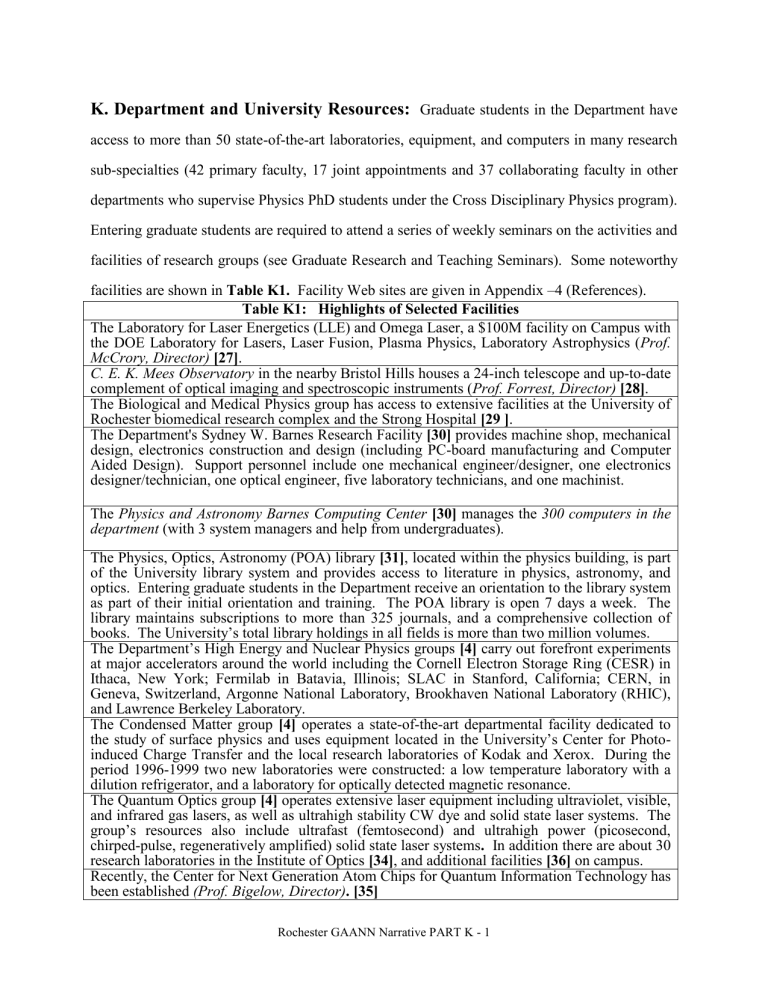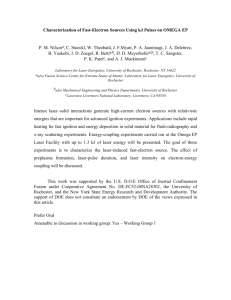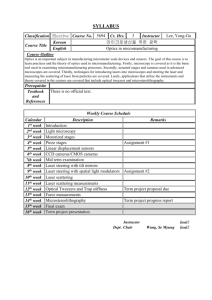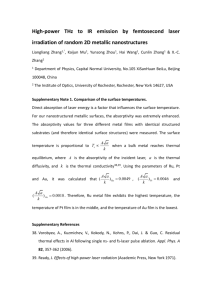Physics-GAANN03-narK - Physics and Astronomy

K. Department and University Resources:
Graduate students in the Department have access to more than 50 state-of-the-art laboratories, equipment, and computers in many research sub-specialties (42 primary faculty, 17 joint appointments and 37 collaborating faculty in other departments who supervise Physics PhD students under the Cross Disciplinary Physics program).
Entering graduate students are required to attend a series of weekly seminars on the activities and facilities of research groups (see Graduate Research and Teaching Seminars). Some noteworthy facilities are shown in Table K1.
Facility Web sites are given in Appendix –4 (References).
Table K1: Highlights of Selected Facilities
The Laboratory for Laser Energetics (LLE) and Omega Laser, a $100M facility on Campus with the DOE Laboratory for Lasers, Laser Fusion, Plasma Physics, Laboratory Astrophysics ( Prof.
McCrory, Director) [27] .
C. E. K. Mees Observatory in the nearby Bristol Hills houses a 24-inch telescope and up-to-date complement of optical imaging and spectroscopic instruments ( Prof. Forrest, Director) [28] .
The Biological and Medical Physics group has access to extensive facilities at the University of
Rochester biomedical research complex and the Strong Hospital [29 ] .
The Department's Sydney W. Barnes Research Facility [30] provides machine shop, mechanical design, electronics construction and design (including PC-board manufacturing and Computer
Aided Design). Support personnel include one mechanical engineer/designer, one electronics designer/technician, one optical engineer, five laboratory technicians, and one machinist.
The Physics and Astronomy Barnes Computing Center [30] manages the 300 computers in the department (with 3 system managers and help from undergraduates).
The Physics, Optics, Astronomy (POA) library [31] , located within the physics building, is part of the University library system and provides access to literature in physics, astronomy, and optics. Entering graduate students in the Department receive an orientation to the library system as part of their initial orientation and training. The POA library is open 7 days a week. The library maintains subscriptions to more than 325 journals, and a comprehensive collection of books. The University’s total library holdings in all fields is more than two million volumes.
The Department’s High Energy and Nuclear Physics groups [4] carry out forefront experiments at major accelerators around the world including the Cornell Electron Storage Ring (CESR) in
Ithaca, New York; Fermilab in Batavia, Illinois; SLAC in Stanford, California; CERN, in
Geneva, Switzerland, Argonne National Laboratory, Brookhaven National Laboratory (RHIC), and Lawrence Berkeley Laboratory.
The Condensed Matter group [4] operates a state-of-the-art departmental facility dedicated to the study of surface physics and uses equipment located in the University’s Center for Photoinduced Charge Transfer and the local research laboratories of Kodak and Xerox. During the period 1996-1999 two new laboratories were constructed: a low temperature laboratory with a dilution refrigerator, and a laboratory for optically detected magnetic resonance.
The Quantum Optics group [4] operates extensive laser equipment including ultraviolet, visible, and infrared gas lasers, as well as ultrahigh stability CW dye and solid state laser systems. The group’s resources also include ultrafast (femtosecond) and ultrahigh power (picosecond, chirped-pulse, regeneratively amplified) solid state laser systems . In addition there are about 30 research laboratories in the Institute of Optics [34] , and additional facilities [36] on campus.
Recently, the Center for Next Generation Atom Chips for Quantum Information Technology has been established (Prof. Bigelow, Director) . [35]
Rochester GAANN Narrative PART K - 1
The Rochester Quantum Information Center [32] (Prof. Carlos Stroud, Director)
The theoretical effort in Quantum Optics is coordinated through the Rochester Theory Center in
Optical Science and Engineering. (Professor Eberly, Director) [33]
A new state of the art Silicon tracking development laboratory and clean room were built for experimental high energy physics group in 2003 [ 44 ] . (Professor Demina, Director)
In 2004, the University will construct a new state of the art MRI facility for Biological Physics
Research [45] ( to be run by Prof. Zhong).
A new upgrade to the LLE is being funded by the Federal Government. The cost of the new facility, OMEGA EP, is $100 million (including the building) plus $30M in equipment. The present Omega laser is the largest and most powerful ultraviolet laser in the world currently in use to study inertial confinement fusion. The sixty beams of the system are symmetrically disposed around the target chamber. The Omega laser can produce more than 30 kJ at 351 nm.
Typically, inertial fusion experiments use nanosecond pulses with laser intensities of 10 15 w/cm 2 incident on a millimeter size pellet containing thermonuclear fuel. The Omega EP facility will consist of 4 beams, 2 capable of PW irradiation. This laser will be used with the 60 beam facility for high energy density physics and novel thermonuclear ignition schemes.
Rochester GAANN Narrative PART K - 2







